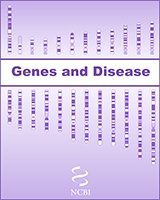NCBI Bookshelf. A service of the National Library of Medicine, National Institutes of Health.
National Center for Biotechnology Information (US). Genes and Disease [Internet]. Bethesda (MD): National Center for Biotechnology Information (US); 1998-.
Immunodeficiency with hyper-IgM (HIM) is a rare primary immunodeficiency characterized by the production of normal to increased amounts of IgM antibody of questionable quality and an inability to produce sufficient quantities of IgG and IgA. Individuals with HIM are susceptible to recurrent bacterial infections and are at an increased risk of autoimmune disorders and cancer at an early age.
In a normal immune response to a new antigen, B cells first produce IgM antibody. Later, the B cells switch to produce IgG, IgA and IgE, antibodies that protect tissues and mucosal surfaces more effectively. In the most common form of HIM there is a defect in the gene TNFSF5, found on chromosome X at q26. This gene normally produces a CD40 antigen ligand (CD154), a protein on T cells which binds to the CD40 receptor on B and other immune cells. Without CD154, B cells are unable to receive signals from T cells, and thus fail to switch antibody production to IgA and IgG. The absence of CD 40 signals between other immune cells makes individuals with HIM susceptible to infections by opportunistic organisms such as Pneumocystis and Cryptosporidium species.

CD40 antigen ligand (CD154)
The gene TNFSF5 that codes for the protein CD154 above, (formerly CD40L) is mutated in HIM. Mutations have been reported throughout the length of TNFSF5, but are most common in the regions that code for ligand binding (arrow), core structure and the subunit (more...)
Treatment of HIM mainly consists of regular IV replacement of the missing IgG antibodies and prompt treatment of infections. Long lasting immunity, however, cannot be maintained without a bone marrow transplant, which is done when a suitable donor is available.
Related diseases
- Genome view see gene locations
- Entrez Gene collection of gene-related information
- BLink related sequences in different organisms
- Research articles online full text
- Books online books section
- OMIM catalog of human genes and disorders
- Primary immune deficiency National Institute of Allergy and Infectious Diseases, NIH
- Immunodeficiency with hyper-IgM - Genes and DiseaseImmunodeficiency with hyper-IgM - Genes and Disease
Your browsing activity is empty.
Activity recording is turned off.
See more...
